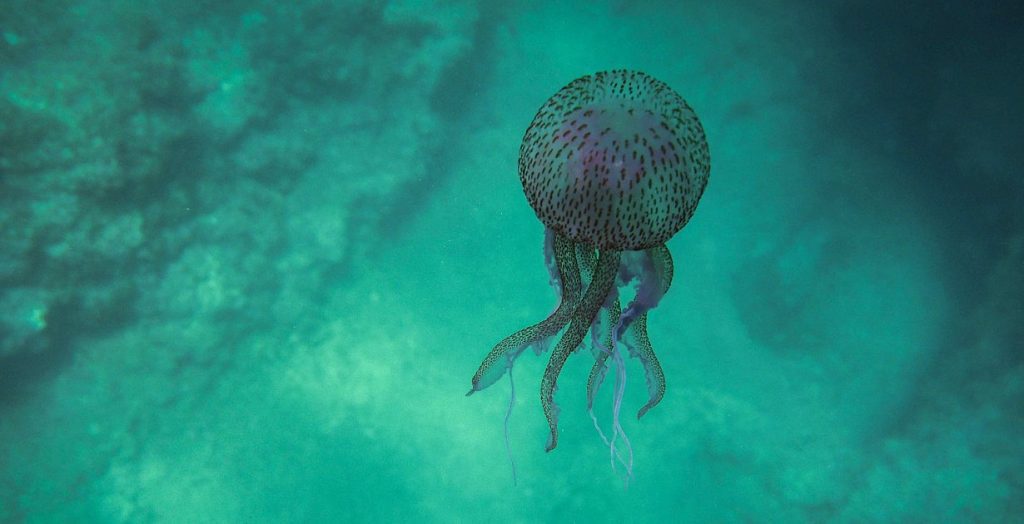They can spoil a day on vacation at the sea: in the Mediterranean, a purple jellyfish, the size of an apple, is increasingly annoying swimmers. Touching their claws is incredibly painful. Scientists see jellyfish not only as a nuisance, but also as research organisms with a wide range of benefits for humans. They help with technological innovations in medicine and agriculture and are used in the manufacture of diapers or in earthquake-resistant construction.
Since mid-June, the fire jellyfish Pelagia noctiluca has multiplied explosively off the coasts of Corsica and the Cote d’Azur as it bathes for holidays on several southern French beaches. Italian Simone Martini can sing a song about it. I caught him on a beach in Ajaccio, Corsica. “After two weeks, the sting still hurts sometimes,” he says of the wound on his forehead.
“Hitting the wound does not help”
There are many tips on how to relieve the pain, but oceanographer Fabien Lombard has skepticism about most methods: “Peing on a wound definitely doesn’t help,” says the expert from the Naval Research Institute Laboratoire d’Océanographie de Villefranche/Mair, laughing. Above all, the affected area should not be “rinsed with sea water or rubbed with sand”.
The squirrel jellyfish releases tiny harpoons that contain a poisonous cocktail of stinging capsules attached to its tentacles. Lombard explains, “Jellyfish are blind, so they sting anything they come across to see if they can eat it. They inject neurotoxins to paralyze their prey and enzymes to digest it.”
Worry about the mud and the seas
Scientists are concerned about jellyfish for other reasons. In a report published in 2019, the Intergovernmental Panel on Climate Change (IPCC) warned that the spread of jellyfish could lead to “gelatinization,” a type of mucous pollution, in the seas. Fabian Lombard has doubts: “We don’t have any reliable measurements that show there are more jellyfish.”
However, he admits, “in the ’80s and ’90s, there were alternately five to six years with jellyfish and five to six years without jellyfish.” But this year “it is already the twenty-fifth in a row with jellyfish.”
However, #Lombard cautions against seeing the jellyfish plague as a problem in and of itself. It is a symptom of overfishing in the seas. For Lovina Volgrabi of the Marine Research Institute of Corsica Starso, the overfishing of tuna and sea turtles, which eat jellyfish, is one of the most plausible hypotheses to explain the frequency of jellyfish occurrence.
Scientific breakthroughs through jellyfish
Jellyfish inhabited the seas about 600 million years ago. Science has some hacks to thank for cnidarians. For example, the 2008 Nobel Prize in Chemistry was awarded for the use of phosphorous from jellyfish in visualizing cell processes, for example in Alzheimer’s disease research.
The US space agency NASA uses jellyfish to study reproduction in weightlessness, and since 2017, the European Union has been working with the “GoJelly” project to find out how jellyfish can be used for nutrition, fertilization or against environmental pollution.
According to Lombard, jellyfish can be used as forage in fish farming or to maintain soil moisture, for example in viticulture or rice cultivation. Jellyfish collagen is sometimes used in nappies or tampons to bind moisture, and in some places it makes concrete more pliable and therefore more earthquake-resistant, says the marine researcher. Research is also being done on how jellyfish can help form cartilage in the human body.
As a last resort, people can still eat jellyfish to limit their numbers. At least that’s what the Food and Agriculture Organization of the United Nations (FAO) proposed in 2013. (apa/ag)

“Food practitioner. Bacon guru. Infuriatingly humble zombie enthusiast. Total student.”







More Stories
KaDeWe stops selling meat and sausages
Another earthquake near the giant Naples volcano
Trump wants to block Harris' access to donations